Ventralex Lawsuits
The Ventralex hernia mesh is one of the most commonly filed hernia mesh lawsuits against the company Bard Davol. Approximately 2,500 Ventralex hernia mesh lawsuits have been filed against Bard in MDL 2846. The Ventralex is the third most common hernia mesh lawsuit filed in MDL 2846, comprising 14% of all hernia mesh lawsuits filed. Versions of the Ventralex hernia mesh are also very similar to the Bard Composix Kugel hernia mesh, which also accounts for a substantial number of hernia mesh lawsuits in MDL 2846. Many consider the permeant ringed type hernia mesh patches, such as the Ventralex hernia mesh to be among the most danger hernia meshes.
Evolution of the Ventralex Hernia Mesh

Decades ago, hernia’s were repaired with flat sheets of mesh placed between the layers of the abdomen – away from the bowel and other sensitive organs. As a way to make implanting hernia meshes easier and next to the bowel, Bard created the Composix Kugel hernia mesh, which came to market in 2001. The Composix Kugel hernia mesh was made of polypropylene mesh on one side to grow into the abdominal wall and expanded polytetrafluoroethylene (ePTFE) or GoreTex on the other side to prevent the patient’s bowel from sticking to the polypropylene portion of the hernia mesh. The Composix Kugel hernia mesh was designed as a patch that would be folded up and then implanted through a small opening. In order for the Composix Kugel hernia mesh to “spring open” after implantation, Bard designed to Composix Kugel to have a permanent polyethylene terephthalate (PET) ring between the ePTFE and polypropylene layers. Bard touted this permanent ring as a “memory recoil” ring. Unfortunately, Bard did not test how the Composix Kugel would perform after being implanted in a human for many years.
Composix Kugel Hernia Mesh Injuries
The Composix Kugel was a widely popular mesh among surgeons once it launched. Many surgeons could now perform certain hernia mesh repairs that they were not previously skilled to. Other hernia mesh surgeons could do hernia mesh repairs faster with the Composix Kugel, allowing them to repair more hernias in a day. As the years went by and actual human data was obtained, failure modes and injures associated with the Composix Kugel became clear.
Chronic Infections
The combination of ePTFE and polypropylene greatly increased the rate of chronic infections observed with the Composix Kugel compared to hernia mesh repairs in general. The ePTFE portion of the Composix Kugel hernia mesh has very small pores that bacteria can live in, but the pores are too small for white blood cells to enter and clear the infection. Additionally, the polypropylene portion of the Composix Kugel is highly inflammatory, which draws fluid and bacteria to the mesh. The combination of ePTFE and polypropylene in the Composix Kugel results in infections that can not be cleared with even IV antibiotics and the mesh typically must be removed in order to resolve the infection.
Bowel Injuries
The unique combination of ePTFE and polypropylene in the Composix Kugel hernia mesh also greatly increases the risk that the patient’s bowel or other internal organs are injured. ePTFE and polypropylene both contract after the hernia mesh is implanted. However, ePTFE and polypropylene don’t contract at the same rate. The ePTFE and polypropylene of the Composix Kugel contracting at different rates results in mesh deformation. Once the mesh deforms, the bowel can be exposed to the polypropylene side of the hernia mesh and become attached to the mesh. Initially hernia mesh adhesions are typically asymptomatic, but over time they can become denser and start to become painful, especially if the bowel becomes obstructed. Many patients had to have additional hernia mesh surgeries because the Composix Kugel was causing a bowel obstruction. In order to remove the Composix Kugel hernia mesh, many patients had to undergo a bowel resection.
As the ePTFE and polypropylene continued to shrink and deform the Composix Kugel, the permanent “memory recoil” ring would eventually break, creating a sharp point in the mesh that was perforating patient’s bowels. Patient’s that experienced ring breaks and buckles with the Composix Kugel typically underwent extensive surgeries and many patient’s even died.
Composix Kugel Hernia Mesh Recall
Bard was able to explain away the high infection rate as being patient specific, but Bard couldn’t ignore the numerous reports that the permanent ring inside the Composix Kugel kept breaking. Bard then did a series of Class 1 recalls of the Composix Kugel hernia mesh in 2005, 2006, and 2007 all related to the permanent ring. The Composix Kugel hernia mesh wasn’t fully discontinued until 2011.
Bard Ventralex Permanent Ring

The Bard Ventralex is like the Composix Kugel, with the addition of some polypropylene positioning straps that can be pulled on to flatten the mesh after implantation. The Ventralex hernia mesh is also generally smaller sizes than the Composix Kugel hernia mesh, though the largest Ventralex and the smallest Composix Kugel do overlap in size. Bard continued to sell the Ventralex hernia mesh with a permanent PET memory recoil ring until 2013, when Bard finally changed to a resorbable polydioxanone (PDO) ring, known as SorbaFlex Memory Technology. Even though Ventralex hernia meshes made after 2013 don’t contain a permanent ring, they are still prone to infection and mesh deformation due to the use of ePTFE in combination with polypropylene. While there were numerous recalls for the Composix Kugel hernia mesh, there have not been any recalls for the Ventralex hernia mesh.
Bard now also makes the Ventralex ST, which utilizes a resorbable adhesion barrier instead of ePTFE like the Ventralex and Composix Kugel utilized. The Ventralex ST is a patch version of the Ventralight ST.
Ventralex Hernia Mesh Attorney
To speak to one of our hernia mesh attorneys, please call 913-800-8518. More information about the Bard hernia mesh lawsuits can be found here. More information about hernia mesh lawsuits in general can be found here. For a free Ventralex hernia mesh lawsuit case evaluation call 913-800-8518.

